Editor's note:
Thanksgiving is around the corner, and you know what that means—a cornucopia of delicious edibles gracing the dining room table, the kitchen counter, and the coffee table. If your dog tends to help herself to your Thanksgiving goodies, read on. You'll be thankful!A new trick
Many dog owners complain that their dogs steal food from kitchen counters or even the dinner table. A new term was even coined to describe this behavior: counter-surfing. If you're tired of losing your dinner to a sneaky pooch every time you turn your back, here's what you can do about it.
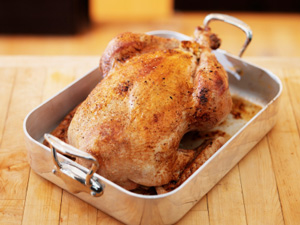
"Stop" strategies
Counter-surfing is unwanted behavior. In operant conditioning, there are three basic approaches to stopping unwanted behavior:
- Punishment through a consequence that diminishes the unwanted behavior
- Extinction (allowing the behavior to fade away on its own) through removal of the reinforcer that is maintaining the unwanted behavior
- Training an alternative or incompatible behavior
The first approach, punishment, has its disadvantages. It is usually (but not always) unpleasant, and therefore not much fun for dog or owner. Judging an effective level of punishment can be tricky. Too much punishment can be damaging, and too little can be ineffective. Other behaviors may end up being punished unintentionally, sometimes causing the dog to simply learn to avoid an entire situation altogether.
If you punish your dog for counter-surfing, for example, your dog may decide that the kitchen was the source of the problem, and opt to avoid the kitchen altogether—which could cause a host of other issues. But by far the most common problem that occurs when punishing counter-surfing is that the dog only learns not to steal food when the owner is around. As soon as the owner leaves the room, watch out!
This leaves us with the remaining two options: extinction and training an alternative or incompatible behavior. If you are new to clicker training, find an index card, write down the following, and stick it to your fridge:
- What is reinforcing this unwanted behavior and how do I remove the reinforcer?
- What would I like my dog to do instead of this unwanted behavior?
Food left unattended on kitchen counters is simply too tempting and too reinforcing for the thieving dog.
Remove temptation
The answer to the first question in this case is easy: FOOD. Recall the adage "opportunity creates the thief." Food left unattended on kitchen counters is simply too tempting and too reinforcing for the thieving dog. Each time your dog manages to find food on the kitchen counter, counter-surfing has been reinforced. Extinction of counter-surfing requires clean kitchen counters. Use storage containers, high shelves, and cupboards so that food is never left unattended within reach of your dog. Clean up countertop spills and tidbits immediately, as even a crumb can be enough to reinforce some dogs.
If food must be left unattended, put your dog in another room and shut the door. There is no sense in providing opportunities for reinforcement when avoiding it is as simple as closing a door.
Try instead
So what would we like our dogs to do instead of counter-surfing? We could choose a specific behavior, such as lying on a mat in the kitchen, and in severe cases we could train and proof this single behavior to be reliable even when we're not in the room—and even when there is juicy steak lying all over the counters!We could train and proof this single behavior to be reliable even when we're not in the room—and even when there is juicy steak lying all over the counters!
If the mat is your dog's normal bed, then he can be taught "go to mat" fairly quickly by capturing this behavior. Simply wait until your dog lies down on the mat on his own, then click and treat. If you toss the treat a short distance away from the mat, you will set up the next trial. When your dog is reliably going back to the mat to lie down, put it on cue.
(If the mat is new to your dog, then you can shape this specific behavior using the instructions found in the free online Book of Training Levels by Sue Ailsby.)
Increase duration
Once you have the "go to mat" behavior on cue, start adding duration. Rather than clicking as soon as your dog goes to the mat, hold off a second before you click and treat. Gradually increase the time before you click, second by second.
Keep the mat in the kitchen or, if space is tight, just outside the door but still in view. When you have 30 seconds of duration on the mat, try asking your dog to "go to mat" the next time you prepare food in the kitchen. Click and treat (toss the treat to your dog on the mat) every 5 seconds at first, then start to build duration up again.
Why lower the criteria to 5 seconds when you know the dog can stay for 30 seconds on the mat? This is a new training picture, and we've introduced distractions (food being prepared), so we have to lower our criteria to a point where the dog can—and will—succeed.
When your dog is staying on the mat while you prepare food for 30 seconds, try leaving the room. Only leave briefly at first, return, and if your dog is still on the mat, click and treat. Again, build duration slowly, at a rate where your dog will succeed.
Eventually, they'll know better
All that most dogs need to know is that there are plenty of opportunities for reinforcement for a range of behaviors that don't include stealing from the kitchen counters. When preparing food, make sure you reinforce nice behaviors such as sitting patiently, or lying down on the floor or a mat. Be sure to leave the room briefly, just to return and reinforce these nice behaviors that are offered even when you're out of the room. At first, be sure to tidy food from the counters so that any counter-surfing is not reinforced.All that most dogs need to know is that there are plenty of opportunities for reinforcement for a range of behaviors that don't include stealing from the kitchen counters.
By combining extinction with regular reinforcement of alternative behaviors, your dog will learn that the most reliable way to get food is to sit patiently, or lie down out of the way. Attempts at counter-surfing will not be reinforced and will eventually go away. If your dog has been reinforced for counter-surfing many times, or intermittently, then the extinction process will take longer—but it will happen.
Remember the two important questions raised above—what is reinforcing this behavior, and what would I like my dog to do instead? These can be applied to virtually any unwanted behavior: raiding the garbage can, barking at the door, jumping on visitors, even pulling on the leash. You hold the power to solve any one of these problems if you can answer those two simple questions and consistently apply the solutions.


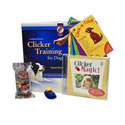
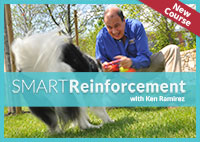
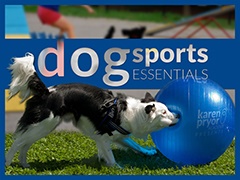
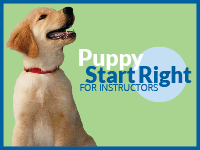
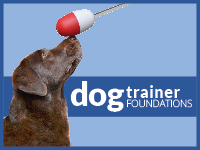

Counter Surfing
My two don't steal food off the counters, they just go along searching. I am new to clicker training and am trying to learn. I have trained other dogs to not even touch my plate if I put it on the floor they would not touch it. But I did not use clicker training to do it. I used my voice. This is where I have a problem with clicker training. I use my voice a lot, This is also what I have problems with too, what happens if I do not have the clicker with all the times when something happens and I want to reward them then what ? I can not clicker right that time I need to. What happens if I am doing something and the dog does what I want and not have the clicker with me at that very moment. I have trained 3 malamutes this way and have also trained a german shepread this way, not using a clicker. I have had a pack, 8 in all and not had a problem, and not used a clicker. When I found out about clicker I was unsure on how it worked. I guess I still am. I am the pack leader and they listen to me. They do not listen to any one else in the family except my husband. He usally lets me do the correction. I am not mean but I act right a the time to get the message across. I will use my voice mostly. So with trying to change to a clicker I am having a problem here. Is there some way to work on this? I am also studying to become a dog trainer. I am wanting to help people with their dogs, so they can learn, and being the pack leader. I am trying to learn more then what I have already. I do have an open mind and am willing to learn more. Thanks for your help. SandyBelle.
Can I use this technique to stop puppy biting
Thanks for the article Aidan!
I recently adopted a puppy. He is 10 weeks old now. He has super high energy and as much as I love him, he seems handful at times. This is my first dog and I am still trying to learn how to handle him.
I have taught him 'sit', 'stay', 'down' and 'fetch' fairly quickly as he is a fast learner. But I have this major problem.He is constantly trying to bite me and I have tried several methods to try and stop this behaviour, but it doesnt work. Few of the things I tried
-- when he jumps on me, I give him the 'sit' command. It works at times, but when he is too excited he ignores it
-- i try giving him a toy to chew on, but he prefers chewing me :)
-- i put him in the crate. He calms down immediately, and I take him out after 5 min. This is the only way that works. But I read in quite a few articles that I shouldn't be doing this, else he will make negative association with the crate.
I have scars all over my hands and I really cant think of anything I can do to stop him! Please please help :(
Hi
Hi Diana
I can totally understand the situations. Perhaps you can create an activity for your pup to engage himself in for a longer period of time. (1)For instance, the big dice-shaped plastic food feeder which the dog rolls it and the content come off little by little. (2)you can recycle a can with a secure plastic lid( i made myself this from an industrial condense milk can) (2)Give him a flavor-encanced rubber chew toy - hidden them in places around the house and you may also be teaching a game. (3)Just confine him in a crate with his toys in it and perhaps feed him in it everytime. also, taking him out for a walk, short ones 4-5 times a day maybe, would also help him relieve the frustration and compulsive behaviours and get tired to go have a nap.
And the important thing to remember is that this is a puppy's tendency to want to chew, and all those puppish behaviours will vanish as he gets matured. My Border-collie and lab cross(will be 6 years old in May) used to be such boistrous and energetic pup who would fanatically try to chew/bite my wrist, and my feet(I once wrapped my feet with bubble wraps to protect! or I would try to go up on the table so that the pup wont be able to reach my feet!), I have a few small scars from him chewing at my wrist). in those days I had not learnt clicker training. but I took him to obedience and dog training courses. I am lucky now that I can use a clicker to teach him anything.
anyway, he gradually matured and no longer had the habits by the age of 1 & a half years old.
All the best.
How about garbage can raiding?
Our 2 Corgis now raid the metal kitchen garbage can every time we leave them alone. We try very hard to empty the can and place an empty plastic bag every time we leave the house. Of course, we haven't reached 100% yet!
The dogs grab the plastic bag, pull the can over on its side and pull out the bag, even when nothing is in the can.
Since we leave the house for several hours, sometimes, how could we change this behavior to leaving the can alone?
Kathy
re: How about garbage can raiding?
Hi Kathy, it would be possible to train this but the effort involved in training the dogs to leave the garbage can alone compared to the effort it would take to manage the situation effectively would make management seem the more attractive option.
The simplest solution is to limit access to the garbage can. We keep our garbage can in the laundry which is next to the kitchen. This is actually to keep our toddler out of it, but I'm sure it has prevented at least one of the dogs learning how to access the contents (which could even be fatal if a cooked chicken bone were to be swallowed). Alternatives are to close the door to the kitchen while you are out, or even to crate the dogs.
But, if your dogs have to pull the can over to access the contents and it is otherwise secure, I would find some way to secure the bin so that it can't be tipped. A brick in the bottom might solve the problem? Or an eye-bolt in the wall to secure a cord looped around the can? I guess you could even bolt it to the floor with a wing-nut if it didn't need to be moved for cleaning very often?
Regards,
Aidan
http://www.PositivePetzine.com
2 questions...
Adian, as usual you are brilliant, concise and encouraging!!
Rita Ippolito
www.savagemermaidswildpugs.com
Counter surfing
I always liked this article Aidan. Great job starting at the beginning and encapsulating the options and approaches.
Post new comment